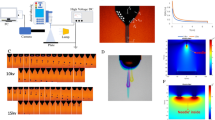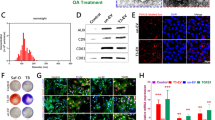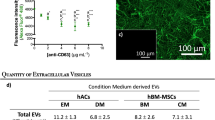Abstract
Embryonic stem cells (ESCs) have attracted particular interest in regenerative medicine because of their unlimited self-renewal and multipotentiality for differentiation. Spontaneous differentiated ESCs display heterogeneous multipotent cell populations and generate teratomas in vivo, with process by which ESCs differentiate into specific lineages remaining unclear. In this study, we focused on the in vitro chondrocyte differentiation of ESCs through micro-mass without using an embryoid body (EB) step and observed the unique characteristics of cartilage formation coupled with endochondral ossification in vivo. This approach resulted in an aggressive loss of discordant cells by apoptosis, which was accompanied by significant changes in gene expression during the course of ESC differentiation into chondrocytes. Unlike EB formation where discordant cells remain trapped within aggregates, micro-mass permits cells to die, leave the group and/or form a new group in response to changes in gene expression. Our observations suggest that the cell death that accompanies ESC micro-mass differentiation helps purify a terminally differentiated cell population and selects for targeted end points within a suitable microenvironment.
Similar content being viewed by others
Log in or create a free account to read this content
Gain free access to this article, as well as selected content from this journal and more on nature.com
or
Abbreviations
- ESCs:
-
embryonic stem cells
- EB:
-
embryoid body
- MSCs:
-
mesenchymal stem cells
- ITS:
-
insulin, transferrin and selenium
- CS:
-
chondrogenic supplement
- 3D:
-
three dimensional
- GAG:
-
glycosaminoglycan
- COL:
-
collagen
- PI:
-
propidium iodide
- H&E:
-
hematoxylin and eosin
- NEAA:
-
non-essential amino acids
- Pen/Strep:
-
penicillin and streptomycin
- βME:
-
2-mercaptoethanol
References
Evans MJ, Kaufman MH . Establishment in culture of pluripotential cells from mouse embryos. Nature 1981; 292: 154–156.
Martin GR . Isolation of a pluripotent cell line from early mouse embryos cultured in medium conditioned by teretocarcinoma stem cells. Proc Natl Acad Sci USA 1981; 78: 7634–7638.
Itskovitz-Eldor J, Schuldiner M, Karsenti D, Eden A, Yanuka O, Amit M et al. Differentiation of human embryonic stem cells into embryoid bodies compromising the three embryonic germ layers. Mol Med 2000; 6: 88–95.
Keller GM . In-vitro differentiation of embryonic stem cells. Curr Opin Cell Biol 1995; 7: 862–869.
Metallo CM, Azarin SM, Ji L, de Pablo JJ, Palecek SP . Engineering tissue from human embryonic stem cells. J Cell Mol Med 2008; 3: 709–729.
Yamada T, Yoshikawa M, Kanda S, Kato Y, Nakajima Y, Ishizaka S et al. In-vitro differentiation of embryonic stem cells into hepatocyte-like cells identified by cellular uptake of indocyanine green. Stem Cells 2002; 20: 146–154.
Shimko DA, Burks CA, Dee KC, Nauman EA . Comparison of in-vitro mineralization by murine embryonic and adult stem cells cultured in an osteogenic medium. Tissue Eng 2004; 10: 1386–1398.
Karp JM, Ferreira LS, Khademhosseini A, Kwon AH, Yeh J, Langer RS . Cultivation of human embryonic stem cells without the embryoid body step enhances osteogenesis in-vitro. Stem Cells 2006; 24: 835–843.
Duplomb L, Dagouassat M, Jourdon P, Heymann D . Differentiation of osteoblasts from mouse embryonic stem cells without generation of embryoid body. In-vitro Cell Dev Biol Anim 2007; 43: 21–24.
Cukierman E, Pankov R, Stevens DR, Yamada KM . Taking cell–matrix adhesions to the third dimension. Science 2001; 294: 1708–1712.
Schmeichel KL, Bissell MJ . Modeling tissue-specific signaling and organ function in three dimensions. J Cell Sci 2003; 116: 2377–2388.
Mackay AM, Beck SC, Murphy JM, Barry FP, Chichester CO, Pittenger MF . Chondrogenic differentiation of cultured human mesenchymal stem cells from marrow. Tissue Eng 1998; 4: 415–428.
Tanaka TS, Kunath T, Kimber WL, Jaradat SA, Stagg CA, Usuda M et al. Gene expression profiling of embryo-derived stem cells reveals candidate genes associated with pluripotency and lineage specificity. Genome Res 2002; 12: 1921–1928.
Egusa H, Schweizer FE, Wang CC, Matsuka Y, Nishimura I . Neuronal differentiation of bone marrow-derived stromal stem cells involves suppression of discordant phenotypes through transcriptional regulation. J Biol Chem 2005; 280: 23691–23697.
Egusa H, Iida K, Kobayashi M, Lin TY, Zhu M, Zuk PA et al. Downregulation of extracellular matrix-related gene clusters during osteogenic differentiation of human bone marrow- and adipose tissue-derived stromal cells. Tissue Eng 2007; 13: 2589–2600.
zur Nieden NI, Kempka G, Rancourt DE, Ahr HJ . Induction of chondro-, osteo- and adipogenesis in embryonic stem cells by bone morphogenetic protein-2: effect of cofactors on differentiating lineages. BMC Dev Biol 2005; 5: 1.
Hwang YS, Polak JM, Mantalaris A . In vitro direct chondrogenesis of murine embryonic stem cells by bypassing embryoid body formation. Stem Cells Dev (in press).
Vormann J, Förster C, Zippel U, Lozo E, Günther T, Merker H et al. Effects of magnesium deficiency on magnesium and calcium content in bone and cartilage in developing rats in correlation to chondrotoxicity. Calcif Tissue Int 1997; 61: 230–238.
Nakayama N, Duryea D, Manoukian R, Chow G, Han CY . Macroscopic cartilage formation with embryonic stem-cell-derived mesodermal progenitor cells. J Cell Sci 2003; 116: 2015–2028.
Sugiki T, Uyama T, Toyoda M, Morioka H, Kume S, Miyado K et al. Hyaline cartilage formation and enchondral ossification modeled with KUM5 and OP9 chondroblasts. J Cell Biochem 2007; 100: 1240–1254.
Hegert C, Kramer J, Hargus G, Müller J, Guan K, Wobus AM et al. Differentiation plasticity of chondrocytes derived from mouse embryonic stem cells. J Cell Sci 2002; 115: 4617–4628.
Kramer J, Hegert C, Guan K, Wobus AM, Müller PK, Rohwedel J . Embryonic stem cell-derived chondrogenic differentiation in-vitro: activation by BMP-2 and BMP-4. Mech Dev 2000; 92: 193–205.
Jukes JM, Moroni L, van Blitterswijk CA, de Boer J . Critical steps toward a tissue-engineered cartilage implant using embryonic stem cells. Tissue Eng Part A 2008; 14: 135–147.
Jukes JM, Both SK, Leusink A, Sterk LM, van Blitterswijk CA, de Boer J . Endochondral bone tissue engineering using embryonic stem cells. Proc Natl Acad Sci USA 2008; 105: 6840–6845.
Toh WS, Yang Z, Liu H, Heng BC, Lee EH, Cao T . Effects of culture conditions and bone morphogenetic protein 2 on extent of chondrogenesis from human embryonic stem cells. Stem Cells 2007; 25: 950–960.
Hessler JA, Budor A, Putchakayala K, Mecke A, Rieger D, Banaszak Holl MM et al. Atomic force microscopy study of early morphological changes during apoptosis. Langmuir 2005; 21: 9280–9286.
Hirsch MS, Cook SC, Killiany R, Hartford Svoboda KK . Increased cell diameter precedes chondrocyte terminal differentiation, whereas cell–matrix attachment complex proteins appear constant. Anat Rec 1996; 244: 284–296.
Doetschman TC, Eistetter H, Katz M, Schmidt W, Kemler R . The in vitro development of blastocyst-derived embryonic stem cell lines: formation of visceral yolk sac, blood islands and myocardium. J Embryol Exp Morphol 1985; 87: 27–45.
Smith AG . Culture and differentiation of embryonic stem cells. J Tissue Culture Methods 1991; 13: 89–94.
Yamashita A, Takada T, Nemoto K, Yamamoto G, Torii R . Transient suppression of PPARgamma directed ES cells into an osteoblastic lineage. FEBS Lett 2006; 580: 4121–4125.
Cormier JT, zur Nieden NI, Rancourt DE, Kallos MS . Expansion of undifferentiated murine embryonic stem cells as aggregates in suspension culture bioreactors. Tissue Eng 2006; 12: 3233–3245.
Yamashita A, Takada T, Omatsu-Kanbe M, Nemoto K, Matsuura H, Yamamoto G et al. Monkey embryonic stem cells differentiate into adipocytes in-vitro. Cloning Stem Cells 2006; 8: 3–9.
Yamashita A, Takada T, Narita J, Yamamoto G, Torii R . Osteoblastic differentiation of monkey embryonic stem cells in-vitro. Cloning Stem Cells 2005; 7: 232–237.
zur Nieden NI, Cormier JT, Rancourt DE, Kallos MS . Embryonic stem cells remain highly pluripotent following long term expansion as aggregates in suspension bioreactors. J Biotechnol 2007; 129: 421–432.
Acknowledgements
We thank Drs John R Matyas and Michael S Kallos for providing scientific advice and support for this study. We also thank Rosaline Alfred and Katherine Chiang for assistance with the FACScan and Vi-Cell XR analysis. This study was supported by National Institutes of Health RO1 grant AR053738-01. AY is an Alberta Heritage Foundation of Medical Research Postdoctoral Fellow (2007) and Japan Society for the Promotion of Science Postdoctoral Fellow for Research Abroad (2008). DER is an Alberta Heritage Foundation of Medical Research Senior Scholar.
Author information
Authors and Affiliations
Corresponding author
Additional information
Edited by RA Knight
Rights and permissions
About this article
Cite this article
Yamashita, A., Krawetz, R. & Rancourt, D. Loss of discordant cells during micro-mass differentiation of embryonic stem cells into the chondrocyte lineage. Cell Death Differ 16, 278–286 (2009). https://doi.org/10.1038/cdd.2008.149
Received:
Revised:
Accepted:
Published:
Issue date:
DOI: https://doi.org/10.1038/cdd.2008.149
Keywords
This article is cited by
-
A FoxA2+ long-term stem cell population is necessary for growth plate cartilage regeneration after injury
Nature Communications (2022)
-
Synovial mesenchymal progenitor derived aggrecan regulates cartilage homeostasis and endogenous repair capacity
Cell Death & Disease (2022)
-
Synergistic Effects of Hypoxia and Morphogenetic Factors on Early Chondrogenic Commitment of Human Embryonic Stem Cells in Embryoid Body Culture
Stem Cell Reviews and Reports (2015)
-
Cartilage tissue engineering identifies abnormal human induced pluripotent stem cells
Scientific Reports (2013)
-
Time-Dependent Processes in Stem Cell-Based Tissue Engineering of Articular Cartilage
Stem Cell Reviews and Reports (2012)



